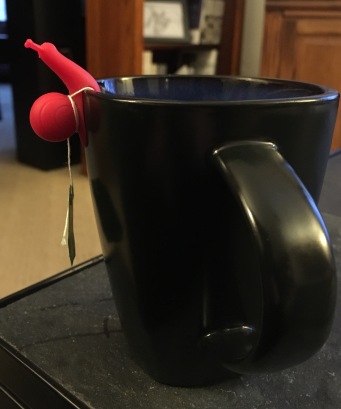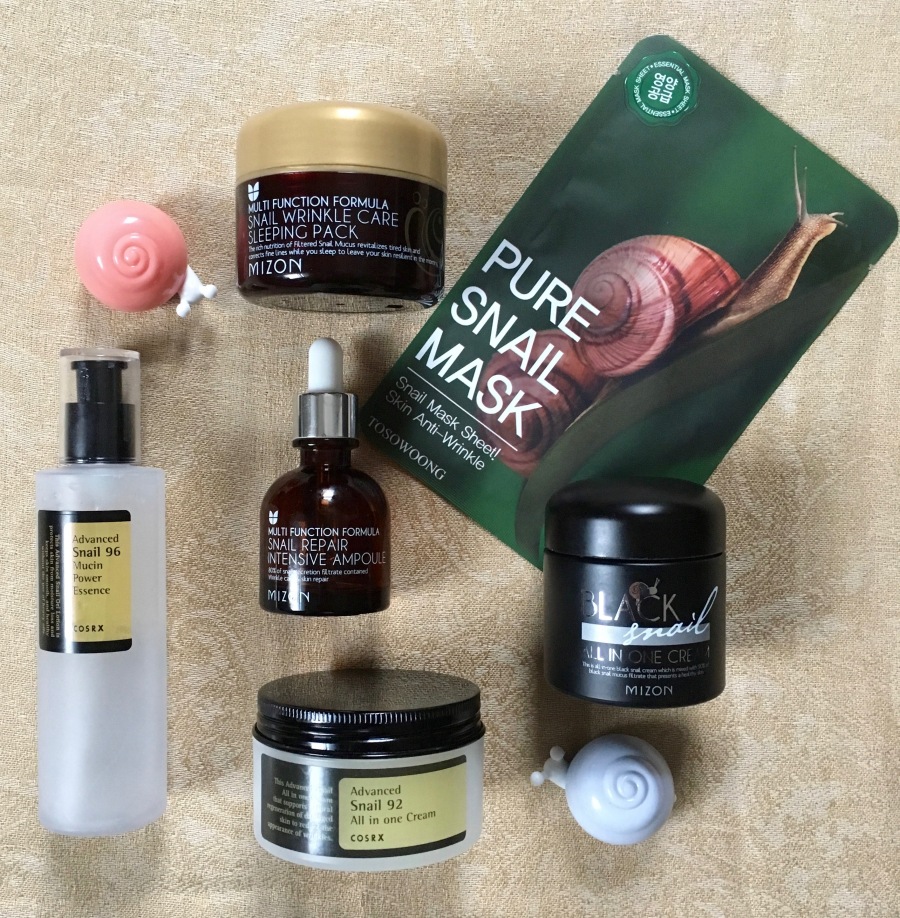“Ew! Snail mucus?!” This is the reaction I get when I tell people about my love of Korean skincare products that are chock full of snail mucin. (The only exception to this is my seventy-something-year old mother, who was completely unfazed by the idea and happily began using the snail cream I gave her for Christmas pretty much immediately.)
If you do any sort of reading about Korean skincare, products containing snail mucin are bound to come up with some frequency, and the sheer variety of Instagram/Twitter names and blogger names that incorporate the word “snail” is amusing. But it shouldn’t be surprising given that snail mucin is a star ingredient in Korean skincare products; people lovingly refer to it as goo, slime, or mucus.

When I first started using snail mucin, my friends definitely questioned
- if this was a hilarious joke that Korean skincare product exporters were playing on gullible Americans to get them to put snail mucus on their faces;
- if there was any actual scientific evidence that snail mucus actually did anything for the skin. (I hang out with academics so of course they asked me this over and over.)
Needless to say, they were skeptical.

Luckily, I do have science on my side.
Why put snail mucus on your face?
Anecdotally, snail mucin calms any redness on my face, provides a burst of hydration, and keeps my skin soft and smooth. Other bloggers credit snail products with speeding up the healing of acne, reducing the appearance of acne scars, or even helping heal burns or cuts.
But rather than giving you purely anecdotal evidence, I’d like to give you some scientific evidence as to why I think snail mucus is a skincare ingredient to love.
While there doesn’t seem to be much specific research on the benefits of snail mucin in skincare products, there has been a fair amount done on snail mucin in relation to its wound-healing properties. While I have been known to put my Cosrx Advanced Snail 96 Mucin Power Essence on small cuts, my interest is how and why it works to heal wounds and what that might mean for my face.
To start, I’d like to quote an article by Harti, et al. at length since it so clearly and succinctly states the wound-healing properties of snail mucin:
“Wound healing with snail slime can be one of the alternatives because it is not only easy to use, but it also can spread well in the skin. In addition, it does not clog skin pores, and it has an antibacterial effect. Snail slime gives a positive reaction to test for protein contents, comprising amino acids and proteins which play role in cell regeneration and growth. The animal protein content of snail slime has a high biological value in wound healing and in the inhibition of inflammatory process. Slime of Achatina fulica can heal wound twice faster than the normal saline solution can.” (Harti, et al. 76)
Harti, Agnes Sri; Sulisetyawati, S Dwi; Murharyati, Atiek; Oktariani, Meri; Wijayanti, Ika Budi. “The Effectiveness of Snail Slime and Chitosan in Wound Healing.” International Journal of Pharma Medicine and Biological Sciences. 5.1 (2016): 76-80.
So, snail mucus has antibacterial properties, doesn’t clog pores, and can help inhibit inflammation! That sounds like a pretty fabulous ingredient for general skincare.
The antibacterial effect noted here was found in S.J. Pitt, et al.’s article on the brown snail’s antimicrobial properties. They found that the common brown snail “has a demonstrable antimicrobial activity against several strains of P. aeruginosa” (178). Pseudomonas aeruginosa is a type of bacteria that causes infections.
Pitt, S. J., M.A. Graham, C. G. Dedi, P.M. Taylor-Harris, A. Gunn. “Antimicrobial properties of mucus from the brown garden snail Helix aspersa.” British Journal of Biomedical Science. 72.4 (2015): 174-181. (Sorry, I can’t link a full text.)
I think this antibacterial property is why so many people find snail mucin products to soothe irritation, calm redness, and heal acne.
Another article, by Adikwu and Alozie, finds that the combination of snail mucin and honey works to heal wounds faster than when the snail mucin alone is used (197). They note the specific role snail mucin plays in healing a wound: “…it enhances the skin’s natural regenerative response on the formation of new tissues, probably through immune response. The smoothness observed in the healing may indicate that the preparation may prevent kelloid formation” (197).
Adikwu, M. U. and B. U. Alozie. “Application of snail mucin dispersed in detarium gum gel in wound healing.” Scientific Research and Essay Vol. 2.6 (2007): 195-198.
So, snail mucin may prevent kelloid scars, which are the raised scars you get after an injury has healed. Guess what is a common cause of kelloid scars? ACNE! That means, according to my new favorite scientists, Adikwu and Alozie, their research indicates that snail mucin may actually help prevent those annoying acne scars.
Further, Adikwu and Alozie found that snail mucin is twice as effective and efficient in healing wounds when pared with honey. Given that honey was already my second favorite skincare ingredient, I definitely began layering these two together after reading this article.

I will note that in my reading, I came across an article that discussed snail allergies.The article made a connection that children with mite allergies also had snail allergies as well.
Now, I can imagine that since most folks don’t go around touching or putting snails on their faces, a person may not know they’re allergic to snails until they try a product that has snail mucin in it. So, if you have a known mite allergy, you should definitely patch-test any snail products before using them.
Aside from those folks with possible allergies, I think that snail mucin products work really well for most skin types: my friend Beth, who has rosacea, notes that her skin loves snail products; another friend who has oily skin noted a dramatic decrease in oil after incorporating snail cream into her routine; I know that my own dry skin soaks it up and is calmed by it.

How is snail mucin harvested?
I know some might not care about how the snails are treated in order to get that sweet, sweet snail goo, but my partner, Mr. Sir, is a vegan, and I’m a pescatarian, so I couldn’t help but research the harvesting process.
Obviously, snail mucin is not harvested the same way in every place. In fact, it is a little difficult to find specific information on snail mucin harvesting, probably due to propriety reasons.
The basic idea, though, is that the snails are stressed, which causes them to produce more mucus, which is then harvested. Sometimes this means having them crawling across crating or other rougher surfaces or sometimes they’re given a light electrical stimulation.
Basically, they’re stimulated in various ways to produce more slime, but they’re not crushed or killed to do so.
Favorite Products that Contain Snail Mucin

Disclaimer: The products below are ones that work well for my skin; they may not work well for yours. Please check cosdna.com for ingredient lists and check for any of your potential triggers.
Cosrx Snail 96 Mucin Power Essence: ($16 Memebox) This is an HG for me. This high concentration of snail mucin (96%!) calms my skin, hydrates, and absorbs quickly. I will repurchase this forever. [Update: read my full review on the blog here!]
Cosrx Advanced Snail 92 All in One Cream: ($15 Memebox) This AIO is a very lightweight cream that is 92% snail mucin. It is thicker than the essence, but I use it as more of a heavy serum or lotion than I do a cream. That is, especially in the winter, I put a cream over this. I find most people use this or the essence, but I like to have this around for when my face is very irritated, or I’ll throw this on as a light cream before I head to the gym so my pores don’t clog as I sweat, but my face doesn’t dry out.
Mizon Black Snail All In One Cream ($10 Amazon) This AIO has 90% black snail mucus filtrate, and is a great option for those who want to use snail mucin but can’t get past the texture: this AIO has a light, whipped texture and feels very much like a regular cream. The viscous, stringy texture (that I love) of other products is absent.
Mizon Snail Repair Intensive Ampoule: ($10 Amazon) Made with 80% snail secretion filtrate, this serum is highly concentrated, making it great for spot treatments or for when you really need to layer on the snail.
Tosowoong Pure Snail sheet mask: ($2 each Memebox) There are a bunch of great snail mucin masks, but I love Tosowoong’s affordability and the fact that their sheet masks are always dripping with essence.
Mizon Snail Wrinkle Care Sleeping Pack: ($16 Memebox) An incredibly smooth, occlusive cream, this sleeping pack locks in moisture better than any other sleeping pack I’ve tried. It does stay tacky for a bit, so I make sure to put it on at least 30 minutes before heading to bed so it doesn’t all come off on my pillow. I wake up to a hydrated, plump, smooth face. It’s really lovely.
Ladykin Affinitic Lifting Cream: (the snail containers) ($15 full size Memebox) I won’t lie: I totally bought these for the packaging. As it turns out, I like the snail cream in them as well (it’s 80% snail secretion filtrate). I have the minis of these–one came in my monthly 3b Box–and I keep them nearby on my desk for any dry patches or even as a hand cream. But let’s be real, these are adorable and that is why I own them.
If you’re interested, here is my referral link to Memebox. You’ll get 20% off of your first purchase if you use it, and I receive a $10 store coupon.
So, how are you feeling about snail mucin products? Interested in adding any to your routine? Or do you already have a favorite?

I must add, that using the honey and Advanced Snail 92 has also helped keep my fingers and hands moisturized, but from putting the product on my face. I use much less hand lotion now than I used to. By the way, I am the 70+ year old Mom.
LikeLiked by 1 person
I use the Tony Moly snail gel, it’s definitely helped calm breakouts and speed up acne healing for me.
Love it!
LikeLiked by 1 person
Ooh, that’s one I haven’t tried! Do you use that as more of a lotion/cream?
LikeLike
I use it after serum and before moisturizer. For me it functions as an acne fighting gel when I get breakouts and need to calm my skin. I also like it for added moisture in very cold days.
LikeLiked by 1 person
[…] It’s an amazing combo that is meant to soften, heal, and brighten my skin. As I detail in my post about snail mucin, honey and snail mucin are best when […]
LikeLike
[…] I’m trying. As I’m realizing, mists aren’t exactly as exciting as snail mucin. […]
LikeLike
[…] Snail Secretion Filtrate: Snail goo is an incredible product that can help heal dry skin, repair damaged skin, heal pimples, etc. See my ode to snail mucin here. […]
LikeLike
[…] of the products in it was their Swanicoco Fermentation Snail Care Skintoner. As you probably know, I love snail mucin (and you should, too!), and I really like toners for adding light layers of hydration. So, I […]
LikeLike
This is a really useful post, snail mucin is now next on my to-buy list 🙂
LikeLike